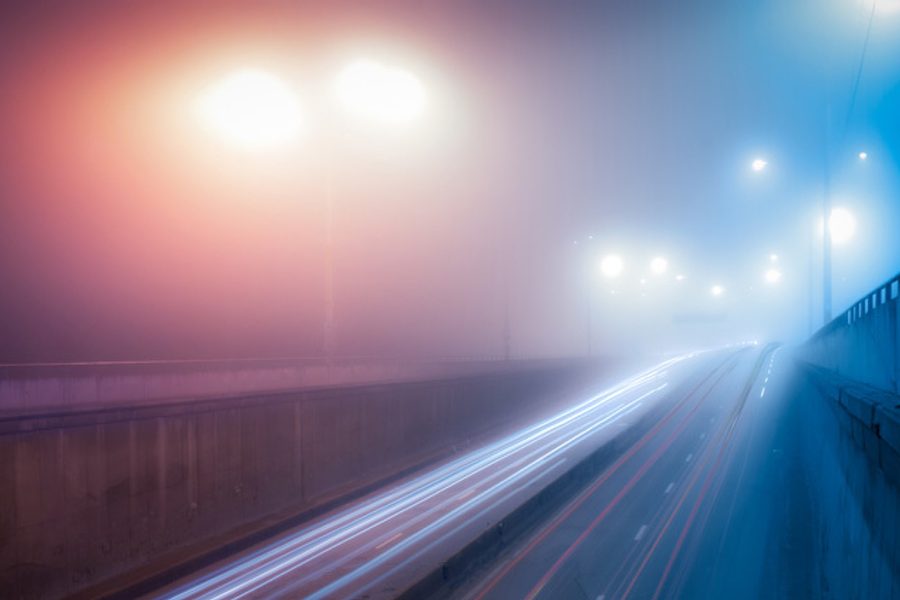
Outdoor lighting creates a warm welcome,” proclaims a full-page ad in a recent issue of Real Estate Journal. The ad urges homeowners to splash decorative and dramatic outdoor lighting all around their yards to “welcome your guests and yourself home while adding elegance, value and safety.” This is typical of the way outdoor lighting is often viewed (and presented by the lighting industry and the architectural profession). Yet, though it may strike a chord deep in our caveman genes, ingrained over millennia as primitive humans hunkered be- hind fires they hoped would repel wild animals, illuminating the night from dusk until dawn carries a host of negative consequences for human health and the environment, nearly all of which are avoidable.
There are some 44 million municipal streetlights in the United States. Most of these are of the older “cobra head” variety, with drop lenses that extend down below the fixture and project much of their light output horizontally — into the eyes of drivers and pedestrians — and even upward into the sky, where it does no good at all. The International Dark- Sky Association, a nonprofit group that advocates for more rational and progressive use of outdoor lighting, estimates that 30 percent of the light from streetlights with drop lenses — and by extension the energy generated to produce it— is wasted. When one considers that there are more private outdoor lighting sources — “security” lights, advertising bill- boards, and purely ornamental floodlights directed at signs, trees and the sides of buildings — than there are streetlights, the true scope of this waste becomes clear.
In addition to wasting electricity, ill-designed outdoor lighting harms human health and our environment in myriad ways.
The important issue in lighting design that’s most often overlooked is that of “color temperature.” Expressed in degrees Kelvin, color temperature is an inverse measurement of the “warmth” of light, with higher Kelvin light sources such as the fluorescent tubes commonly used in office buildings producing “cooler” or bluer light, while lower Kelvin sources like standard incandescent blubs radiate “warmer” or redder light. In practice, lower Kelvin light is perceived as intimate and calming.
In outdoor lighting, a cool tint has significant drawbacks. According to a 2011 study published in the Journal of Environmental Management, when blue light seeps into people’s homes at night through windows or slats in blinds, it can alter circadian rhythms and suppress melatonin production, leading to difficulty sleeping. A low melatonin level has also been linked to breast and prostate cancer. What’s more, blue light contains ultraviolet light, which cannot be seen, but can damage retinas and contribute to macular degeneration. Abraham Haim, director of the Center for Interdisciplinary Chronobiological Research at the University of Haifa and coauthor of the study, urges that “short wavelengths should be eliminated from the nocturnal spectrum.”
According to an American Medical Association report, other health problems that may be exacerbated by the light “include obesity, diabetes, depression and mood disorders, and reproductive problems.” In 2012, the American Medical Association formally recommended that more research be conducted “on the risks and benefits of vocational and environmental exposure to light-at-night, the risk of cancer and the exacerbation of chronic diseases.”
But municipal governments enthusiastic about energy-saving lighting have generally ignored the implications of color temperature. Now that mercury- vapor lights are being phased out be- cause of their poor energy efficiency and high mercury content, the most problematic outdoor light source in common use are blue-white metal-halide lamps, the kind of lights that illuminate stadiums and ball fields. Essentially the next generation of the mercury-vapor technology, metal-halide bulbs are not only blue-tinged but emit a substantial portion of their light in short wave- lengths such as ultraviolet.
There are several alternatives to blue metal-halide light. A commonly used bulb in streetlights today is the more energy efficient high-pressure sodium (HPS) type, which produces the yel- low light familiar to most Americans. Low-pressure sodium (LPS) bulbs are even more energy efficient and pro- duce essentially no blue or UV light, making them a better choice than HPS bulbs in terms of health and environ- mental effects.
Recently, however, it is light-emitting diode (LED) technology, which is highly energy efficient, that has captured the imaginations of lighting engineers across the nation. “White” LED bulbs are available in a wide range of color temperatures, and LED lighting on the “warmer” side of the spectrum is more benign in its effects on human health and the environment. However, urban planners often do not take these differences into account.
For that reason, citizens should pay attention when their municipal governments propose large-scale replacement of older HPS lamps with LED bulbs, since the effects of these decisions will be with us for many years to come. LED lamps have an extremely long life. The
next economical opportunity to re- place them may not come for a decade or more, when the first generation of LED lamps finally cease to function.
Lighting the way
The goal should be better light, and less light. Streetlights with full cut-off fixtures (flat lenses that are not visible from the side or above) project light downward at the street below, and not upward or horizontally, making them preferable to the more commonly used protruding drop lenses. Most street- lights could also be far less bright and still be adequate for safety, while consuming less electricity and reducing the associated carbon dioxide emissions.
Intersections do usually need to be lit (ideally with “yellower” lights), but on a straightaway, bright lights mostly serve to increase drivers’ confidence and speed — not necessarily a good thing. Compounding the problem, blue-white light such as that emitted by metal- halide or cool white LED bulbs causes more glare than the yellower light produced by sodium vapor lamps. The human eye instinctively reacts to the sudden onslaught of blue and UV light by contracting the pupil to protect the retina. Then, when drivers, walkers or bikers pass back out from under the streetlight, they are temporarily blinded as their eyes struggle to readjust to more normal nighttime conditions. This effect leads to an increased risk of accidents in the areas drivers pass through immediately after leaving the cone of illumination of a blue-white streetlight. Outdoor lighting is incorrectly perceived to improve safety in other ways as well. Counterintuitively, dark streets and houses are often more safe than brightly lit areas. Thieves and other criminals need light in order to “work” — and a potential intruder using a flashlight in a dark area can be quite conspicuous — while pedestrians blinded by the glare from overly bright or poorly shielded fixtures have difficulty spotting threats. In fact, the famous 1998-99 Chicago Alley Lighting Project found that “improved” lighting was associated with an overall 40 percent increase in crime and a whopping 77 percent rise in thefts and burglaries. This surprising result makes sense when one considers that a brightly lit alley-way will attract more walkers to what may be a dangerous place. Many cities and towns around the world have dramatically reduced outdoor lighting and experienced an unexpected decline in crime and accidents.
Endangered wildlife
Given that most streetlights operate on photosensors and so are on from dusk until dawn, perhaps an average of 12 hours each day, it seems obvious that there must be some impact on wild animal species that evolved over millions of years in conditions of nighttime darkness. And this is indeed the case. Like people, animals benefit from regular periods of darkness and suffer in their absence. This is especially true for nocturnal animals, for which feeding, mating and other vital behaviors are strongly (and negatively) influenced by artificial nighttime illumination.
Most of us are familiar with the attraction of nocturnal insects, particularly moths, to outdoor lights, but it is not widely understood just how negatively insect populations are affected by artificial lighting. All the time and energy that insects expend circling endlessly about a lit bulb, which they may mistake for the moon, necessarily de- tracts from their ability to successfully find food or mates, while making them easy prey for predators such as spiders.
A 2003 German study suggested that each streetlight in that nation was responsible for the deaths of, on average, 150 insects each night. Assuming a similar figure applies for each of the 35 million streetlights in the United States, we might conclude that a staggering 5.25 billion insects die at streetlights on a typical American summer night. Even if one does not particularly care for in- sects per se, these creatures are a vital link in the food chain, providing sustenance for thousands of species of birds, bats, reptiles and amphibians, and pollinating countless millions of flowering trees and plants each year.
Their detrimental effect on insect populations is one reason to eliminate unnecessary or ornamental outdoor lights and use less bright, better shielded bulbs where possible, but it is also a reason to switch from blue-white bulbs to yellower LEDs or sodium-vapor lamps. Insects (and most other wild animals) are most sensitive to light at the bluer end of the spectrum, including UV light, which is visible to insects. As a result, insects are more drawn to, and thus fatally ensnared by, blue-white lamps. A 2000 German study published in Natur und Landschaft found that the yellowish sodium-vapor lamps attract 50 percent fewer nocturnal insects — and 75 percent fewer butterflies and moths — than the blue-white mercury- vapor lamps. It is therefore reasonable to conclude that replacing a single mercury-vapor or metal-halide streetlight bulb with a high or low-pressure sodium bulb could save the lives of 10,000 or more insects each year.
In addition to their harmful effects on insects, bright and abundant outdoor lights frighten salamanders and frogs, discouraging them from emerging from their daytime hiding places (in leaf litter, etc.) to feed or mate, and consequently reducing their populations as well. But the most detrimental effect of all is on bird migrations. Birds, accustomed to navigating by the moon, become disoriented by lights that are directed upward — either intentionally, as with ornamental floodlights aimed up into tree canopies, or unintentionally, by poorly shielded outdoor fixtures or buildings with large, illuminated windows. In North America alone, estimates for the number of birds killed each year in collisions with lighted structures range as high as 100 million. This is a powerful reason to properly shield outdoor lights so they do not shine into the sky. The same argument can be made for turning off indoor lights when nobody is around, as well as taking the simple step of drawing the blinds or curtains at night. Your lo- cal wildlife, and likely your neighbors as well, will thank you.
Beyond all these earthbound concerns lie the celestial. Night light blocks our view of the starry sky, a connection to the cosmos that has inspired poets and dreamers for millennia. Two of our most gifted bards have found solace in the night sky, as should we.
Hello darkness, my old friend,
I’ve come to talk with you again.
—Simon & Garfunkel, “The Sounds of Silence”





